
California Missions – San Antonio de Padua
Founded: July 14, 1771 – Third of the California Missions
Special Designation: Mission of the Sierras
Named For: Saint Anthony of Padua, a thirteenth century Franciscan, the finder of lost possessions
Mission Site: Located in the Santa Lucia Mountains in an oak studded valley southeast of Monterey, on a what is presently a military reservation. The setting of this mission is much as a traveler would have seen two centuries ago.
Layout: Traditional quadrangle, largely restored by W.R. Hearst and the Franciscans between 1948 and 1952.
Special Attraction: The extensive restoration and unspoiled setting of San Antonio de Padua makes this one of the most picturesque missions in California. It has an extensive museum with a number of exhibits displaying various aspects of daily life at the mission. The site also boasts the most complete, and largely unrestored, Mission-era water control system in California.
Current Status: A retreat center.
Full Post
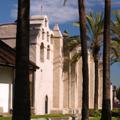
California Missions – San Gabriel Arcángel
Founded: September 8, 1771 – Fourth of the California Missions
Special Designation: Pride of the Missions
Named For: Gabriel, Holy Prince of Archangels
Also Called: Mission San Gabriel
Mission Site: The mission was originally established along the slopes of the Montebello hills at the native site of Shevaanga, overlooking the San Gabriel Valley. In 1775 the mission was relocated to the native site of Iisanchanga “about a league” (3 miles) to the northwest. This mission is 9 miles east of downtown Los Angeles.
Layout: Traditional quadrangle, with soldier’s barracks, neophyte housing, warehouses, and other structures (forming a second incomplete quadrangle) extending out from the central compound.
Mission Church: The unique San Gabriel church, completed in 1805, features a Moorish, “fortress-like” appearance, with capped buttresses and long narrow windows along the prominent side wall. The style is similar to the Cathedral in Cordova Spain.
Current Status: Active Roman Catholic Church of the Archdiocese of Los Angeles.
Full Post

California Missions – San José
Founded: June 11, 1797 – The Fourteenth of the California Missions
Named For: Saint Joseph, husband of Mary, the mother of Jesus
Also Called: The Mission of the Most Glorious Patriarch Saint Joseph
Mission Site: In Fremont, 15 miles northeast of the pueblo (and current city) of San Jose.
Layout: The layout was more of a rectangle than the traditional quadrangle
Mission Church: The simple but powerful San José church is a restoration of the 1809 church, which was destroyed in an earthquake in 1868. The authentic restoration was completed during 1982-85.
Current Status: An active church that is part of Saint Joseph’s Parish.
Full Post

California Missions – San Juan Bautista
Founded: June 24, 1797 – The 15th of the California Missions
Special Designation: Mission of Music
Named For: St. John the Baptist
Also Called: La Misión del Glorioso Precursor de Jesu Cristo, Nuestro Señor San Juan Bautista (The Mission of the Glorious Precursor of Jesus Christ, Our Lord San Juan Bautista)
Mission Site: Located on the main plaza in the town that developed around the mission, some 90 miles southeast of San Francisco.
Mission Church: The present church was dedicated on June 23, 1812, and replaced the much smaller adobe chapel of 1797-98 built by Ygnacio Barrera, Second Carpenter of the frigate Concepción. In 1818 Anglo-American carpenter Felipe Santiago (Thomas Doak), the earlies American settler in California, painted (and very likely constructed) the main altar reredos after a design by Fr. Estevan Tapis.
Special Attraction: San Juan Bautista offers the best opportunity to see and appreciate the California of 160 years ago. There are some 30 historic buildings in the 12-block area surrounding the Spanish Plaza (the only original one remaining in the state) including the Mission’s original adobe manjerio (nunnery), since renamed Plaza Hall and the fomer cuartel (Soldier’s barracks) retrofitted by Angelo Zanetta in 1858 as the Plaza Hotel.
Current Status: Active Catholic church since 1797, now under the Roman Catholic Diocese of Monterey. The existing adobe church has seen continuous use since 1812.
Full Post

California Missions – San Juan Capistrano
Founded: November 1, 1776 – The Seventh of the California Missions
Special Designation: Pride of the Missions
Named For: St. John of Capistrano, a 14th century theologian
Mission Site: Located within sight of the ocean in the town of San Juan Capistrano, which developed around the mission.
Layout: Traditional quadrangle
Mission Church: In 1778, two years after the mission was moved to the present site, a small adobe chapel was built, and soon replaced by the Serra Chapel in 1782. This is the only remaining church in which Fr. Serra held mass. In order to accommodate the mission’s growing population, the Great Stone Church was constructed between 1797 – 1806. This cathedral-like building was 180 feet long by 40 feet wide, and had a high-vaulted ceiling surmounted by seven domes fronted by a 120 foot tall bell tower. In December, 1812 a massive earthquake destroyed the Great Stone Church, killing 40 neophytes.
Special Attraction: San Juan Capistrano, with its beautifully landscaped grounds and with the ruins of the
Great Stone Church and adjacent bell wall, is one of the most picturesque sites in California.
Current Status: The Mission San Juan Capistrano Basilica (a large modern church) and the Serra Chapel are part of the Catholic Parish of San Juan Capistrano.
Full Post

California Missions – San Luis Obispo de Tolosa
Founded: September 1, 1772 – 5th of the California Missions
Named For: St. Louis, Bishop of Toulouse, France, a 14th century Franciscan
Also Called: Mission San Luis Obispo
Mission Site: Located in a spacious valley along the central coast which the Spanish named “La Cañada de los Osos” (Valley of the Bears) when they discovered many grizzlies there. Unlike many of the missions which we re-situated over time, San Luis Ob?spo stands on its original site.
Layout: Traditional quadrangle
Mission Church: The San Luis Ob?spo church was built in 1792-94. The prominent numbers inscribed on the church facade refer to the year the mission was founded in 1772. The vestibule was added in 1820. The former convento (which now contains a museum and gift shop) has a distinctive front colonnade of eleven round columns set on square pedestals.
Special Attraction: The mission has an excellent museum with a special room that focuses on the Chumash Indians. The adjacent plaza is a popular site for community events. A stream runs through the area.
Current Status: Central parish church for city of San Luis Obispo.
Full Post

California Missions – San Luis Rey de Francía
Founded: June 13, 1798 – The 18th of the California Missions
Special Designation: King of the Missions
Named For: King Luis IX of France, who led crusades to the Holy Land in the 13th century.
Also Called: Mission San Luis Rey
Mission Site: Located on a hill overlooking a peaceful valley at the native village of Tacayme in the region know as Quechia, about five miles east of present day Oceanside.
Layout: San Luis Rey extended over six acres. By 1826 the quadrangle measured 500 feet on each side. There was a long corridor with thirty-two Roman arches in front of the patio.
Mission Church: The San Luis Rey Church, completed in 1815, is the only surviving mission church laid out in a cruciform plan. It is 165.5 feet in length and the nave spans 27.5 feet in width by 30 feet in height. A cupola – unique among the California missions – is an octagonal lantern formed of 144 panes of glass. It tops the wooden dome built over the sanctuary in 1829.
Special Attraction: The sunken garden and lavanderia (laundry), located in a hollow to the south of the mission may be reached by descending 46 fire tiled steps. Two springs provided water that sprouted from the mouths of sculpted gargoyles into the lavanderia.
Current Status: A consecrated Roman Catholic church attached to the Franciscan community of San Luis Rey de Francia.
Full Post
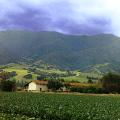
California Missions – Nuestra Señora de la Soledad
Mission Soledad deteriorated rapidly after secularization. It served for several years as the Felilano Soberanes ranch house, a grocery store and a restaurant and was then abandoned for almost 100 years. The Daughters of the Golden West restored the chapel in 1953, and the convento wing (present day museum) in 1963
Founded: October 9, 1791 – Thirteenth of the California Missions
Named For: Our Lady of Solitude (Also Called Soledad Mission)
Mission Site: Thirty miles southeast of Monterey in the Salinas River Valley at a site thought to have been an Esselen village known by the natives as Chuttusgelis.
Layout: A courtyard-centered quadrangle with out-buildings. Neophyte housing was located to the south and the cemetery to the east.
Special Attraction: The grounds, which still contain the ruins of the mission’s adobe walls, are a haunting reminder of how difficult life must have been at this remote and desolate mission.
Current Status: A chapel of Our Lady of Solitude Catholic Church is in the town of Soledad
Full Post

California Missions – San Buenaventura
Founded: March 31, 1782 – Ninth Mission
Special Designation: Mission by the Sea
Named For: Saint Bonaventure, a 13th century Franciscan cardinal and renowned philosopher.
Mission Site: The mission was located near the sizeable Indian village of Mitsquanaqa’n with about 500 inhabitants. San Beuenaventura is 70 miles north of Los Angeles in the city of Ventura, which developed around the mission.
Layout: Traditional quadrange, which was still standing as late as 1875.
Mission Church: The first church was destroyed by fire in 1793. The second church was dedicated in 1809, and reconstructed in 1816 after an earthquake. The walls are six foot thick near the base. The church had to be restored after it was “modernized” in 1893. Restoration was completed in 1957
Special Attraction: There is a well-landscaped garden with a fountain, stone grotto, and exterior displays on the east side of the church. The inviting mission museum (built in 1929) contains the original church doors and two original wooden bells, which were used during Holy Week when the metal bells were silent..
Current Status: Active Roman Catholic Church of the Archdiocese of Los Angeles.
Full Post
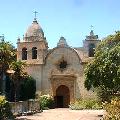
California Missions – San Carlos Borromeo de Carmelo
Founded: June 3, 1770 – Second of the California Missions
Special Designation: Father of the Alta California Missions
Named For: Saint Charles of Borremeo, a 16th century Italian cardinal.
Mission Site: Originally established at the presidio in Monterey but relocated in 1771 to the Carmel Valley on a hillside that was “two gunshots” from the ocean.
Layout: An irregular shaped quadrangle. Only the ruins of the church remained standing when restoration began in 1921, so extensive excavation of the old foundation was required to determine the precise layout of the mission.
Mission Church: The stunning Carmel church (the seventh Carmel church) was completed and dedicated in 1797. The sandstone for the church was quarried by Indian laborers under the direction of master stonemasons Manuel Esteban Ruiz and Santiago Ruiz. The walls are five feet thick at the base.
Special Attraction: One of the most popular attractions is the elaborate Serra Memorial Cenotaph (a momunent not a tomb) sculpted in 1924 by Jo Mora. This is made of travertine marble and bronze and shows life-sized figures of Fr. Serra and three other pioneer missionaries, all of whom are buried under the church sanctuary.
Current Status: A Catholic Church designated a Minor Basilica in 1969 by Pope John XXIII.
Full Post

California Missions – San Diego de Alcalá
Founded: July 16, 1769 – First of the California Missions
Special Designation: Mother of the Alta California Missions.
Named For: St. Didacus of Alcalá, a fifteenth century Spanish Franciscan. The Bay of San Diego was discovered in 1542 by Juan Rodriguez Cabrillo but named San Diego in 1602 by the explorer Sebatián Vizcaíno, who mapped the coast.
Also Called: Mission San Diego
Mission Site: The mission was originally located on Presidio Hill overlooking the bay, at a location called Cosoy by the natives. The mission was relocated about five and a half miles inland at the village of Nipaguay in 1774.
Layout: Traditional quadrangle
Mission Church: The church was originally built in 1813 (the third church on this site). It was rebuilt and fully restored in 1931.
Special Attraction: A popular stop on the mission tour is a re-creation of Fr. Serra’s cloister or living quarters.
Current Status: Active Roman Catholic Church of the diocese of San Diego, properly referred to as the Mission Basilica San Diego de Alcala.
Full Post

California Missions – San Fernando Rey de España
Founded: September 8, 1797 – The Seventeenth of the California Missions
Special Designation: Mission of the Valley
Named For: St. Ferdinand, King of Spain in 13th century.
Also Called: San Fernado Mission
Mission Site: Established at the native site of ‘Achooykomenga/Paskeeknga, In a spacious valley on the Spanish grazing concession of Rancho Los Encinos held by Don Francisco Reyes. Whereas the Spanish referred to the region as El Valle de Santa Catalina de Bononia de los Encinos, the Tataviam called the area Achois Comihabit.
Layout: Traditional quadrangle. A large hospice called the Convento, or Long Building, branched off the quadrangle.
Mission Church: The simple mission church is an exact replica of the 3rd church completed in 1806 and destroyed by an earthquake in 1971.
Special Attraction: The Convento or Long Building, built in 1822, served as the padre’s quarters and as a guest-house. A colonnade with nineteen arches borders the full length of the building, which measures 243′ x 50’.
Current Status: Active Roman Catholic Church of the Archdiocese of Los Angeles.
Full Post

California Missions – San Francisco Solano
Founded: July 4, 1823 – The Twenty-first and last of the California Missions
Named For: Saint Francis Solano, a Spanish Franciscan who served for 20 years as a missionary in Peru and Paraguay.
Also Called: Sonoma Mission
Mission Site: In the center of Sonoma, 40 miles north of San Francisco.
Layout: Traditional quadrangle, near which the town of Sonoma developed.
Mission Church: The current church is an authentic restoration of the 1840 church, rebuilt in 1911-13 with the support of the Historic Landmark League, which acquired the property in 1903. The last major restoration was in 1943-44. The church measures 105 feet long and is 22 feet wide.
Special Attraction: The wing that was the padre’s quarters is now a museum. What was the dining room in this section of the mission now displays mission paintings done by Chris Jorgensen between 1903-1905. The Mexican-era soldiers barracks (just across from the mission) has been restored and now contain a small museum and a gift shop.
Current Status: Sold to a private party in 1881. Now part of Sonoma State Historic Park.
Full Post

California Missions – San Francisco de Asís
Founded: October 9, 1776 – The Sixth of the California Missions
Named For: Saint Francis of Assisi, founder of the Franciscan Order
Also Called: Mission Dolores
Mission Site: Near San Francisco Bay which the Spanish had just begun to explore. (Juan Manuel de Ayala sailed into the Bay in the San Carlos on August 5, 1775). The mission is now located about a half mile from the original site, at present day 16th and Dolores Streets.
Layout: Traditional quadrangle, completed in 1798.
Mission Church: The small chapel (114′ long by 22′ wide) was dedicated on August 2, 1791. It has survived earthquakes, fires and other calamities. It was restored in 1917 and received a complete restoration and retrofit in 1990 and 1994. The ceiling has a distinctive chevron design painted with natural pigments.
Special Attraction: The cemetery (much reduced from its original size) is a well landscaped oasis in the middle of a busy city. The mass grave of the Mission Indians buried here is called the Grotto of Our Lady of Lourdes Shrine.
Current Status: The old mission chapel is part of the Basilica Parish of Mission Dolores. The basilica, which towers over the original mission, was dedicated in 1918. Basilica status was granted in 1952.
Full Post
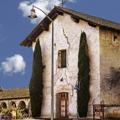
California Missions – San Miguel Arcángel
Founded: July 25, 1797 – 16th of the California Missions
Special Designation: Mission on the Highway
Named For: Saint Michael the Archangel
Also Called: Mission San Miguel
Mission Site: About halfway between San Francisco and Los Angeles in the town that developed around the mission. The site was called Valica by the Saliman and Paraje de los Pozos by the Spanish. It was surrounded by level land that was suitable for growing wheat.
Mission Church: The present church, begun in 1816 under the direction of Fr. Juan Martin, was completed in 1818. A picturesque colonnade which leads to the church contains twelve arches of different sizes and shapes, unique among the California missions.
Special Attraction: The worn adobe walls, ancient gateways, and simple adobe structures of the mission complex make this one of the most authentic looking missions in the chain.
Current Status: Parish Church of the Roman Ctholic Diocese of Monterey, and post-mission period Franciscan novitiate since 1928-29).
Full Post

California Missions – Santa Bárbara
Founded: December 4, 1786 – The Tenth of the California Missions
Special Designation: Queen of the Missions
Named For: Saint Barbara, a legendary martyred church figure of the 3rd century.
Mission Site: In the city of Santa Barbara on a hill commanding a striking view of the sea.
Layout: Santa Barbara was laid out in the traditional quadrangle, with separate granaries, a weavery with patio, tannery, and neophyte housing forming additional courtyard-oriented squares. Many of the exisiting buildings at the rear of the mission complex, however, were created to meet the needs of the seminary, established in the 20th century. Most of the new construction follows the foundations of the old quadrangle.
Mission Church: The church was completed in 1820 with one tower. The second tower was added in 1831, collapsed within two years, and was rebuilt in 1833. The Neoclassic facade was inspired by a mission archives copy of the Spanish edition of The Six Books of Architecture by Marcus Vitruvius Pollio. a Roman architect of 1st century B.C.
Special Attraction: The beautiful Moorish fountain located in front of the monastery wing, to the left of the church, was sculpted by mason and carpenter José Antonio Ramírez in 1808.
Current Status: Active Roman Catholic Church owned and operated by the Franciscans.
Full Post

California Missions – San Rafael Arcángel
Founded: December 14, 1817 – Twentieth of the California Missions
Special Designation: Mission of Bodily Healing.
Named For: Saint Rafael, patron of good health and travelers.
Mission Site: 15 miles north of San Francisco at the native site of ‘Anaguani. Since San Rafael was intended to be a “hospital” asistencia, a key consideration was that the location be in a sunnier and more protected environment than San Francisco, which was foggy, damp and windy. The original mission buildings were razed in 1870. In 1919 the new St. Raphael Parish Church, with an imposing tower, was built on the site of the original chapel.
Layout: No effort was made to build a full complex. The initial building was a structure that measured 87 feet in length and 42 feet in width. It contained a hospital, chapel, padre’s quarters and a storage area.
Mission Church: In 1949 a replica of the original mission chapel was constructed on mission property to the right of the main church built in 1919. The replica has a Mudejar or star window said to have been copied from that at the Carmel Mission.
Current Status: The mission Chapel is used for special events and is part of the parish of St. Rafael of the Roman Catholic Archiocese of San Francisco.
After the mission ruins were removed in 1870, all that remained of the old mission site was a solitary pear tree. In 1909 the Native Sons of the Golden West erected a bell and sign on the original site.
Full Post

California Missions – Santa Clara de Asís
Founded: January 12, 1777 – Eighth of the California Missions
Named For: Saint Claire of Assisi, a 13th century Italian nun, cofoundress with San Francis of the Order of Poor Clares or Clares.
Also Called: Mission Santa Clara
Mission Site: Located on the southern end of San Francisco Bay in Santa Clara, on a site originally chosen by Jan Bautista de Anza, the Spanish Pathfinder. The site was originally founded as La Mision de Santa Clara de Thamien at the Costanoan village of Socoisuka on the Guadalupe River. The mission was destroyed and rebuilt on six successive occasions.
Layout: Traditional quadrangle
Mission Church: The current church is a tasteful modern interpretation of the mission’s fifth church constructed in 1825. The 1825 church was completely destroyed in a devastating fire.
Special Attraction: The well landscaped grounds of this mission, nestled in the middle of a large university, are quite appealing. A portion of the original adobe walls have been preserved.
Current Status: An active Catholic Church of the Roman Catholic Dioces of San Jose that is the spiritual center of a modern Jesuit university.
Full Post
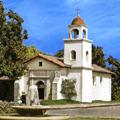
California Missions – Santa Cruz
Founded: August 28, 1791 – Twelfth of the California Missions
Named For: The Exaltation of the Holy Cross of Christianity
Mission Site: On a bluff in the city of Santa Cruz, near the mouth of the San Lorenzo River and the native site of Uypi on the Monterey Bay. Moved to this location in 1793.
Layout: Traditional quadrangle with a large garden and orchard near the mission.
Mission Church: The current mission chapel is a well-executed smaller one-third scale replica of the 1795 mission church. It was erected in 1931.
Special Attraction: A portion of the original nephyte housing area of 1822 has been restored and may be seen in the adjacent Santa Cruz Mission State Historic Park.
Current Status: Parish Chapel of the parish of the Holy Cross of the Roman Catholic Diocese of Monterey. The mission chapel is a popular site for weddings.
Full Post

California Missions – Santa Inés Virgen y Martír
Founded: September 17, 1804 – The Nineteeth of the California Missions
Special Designation: Mission of the Passes
Named For: Saint Agnes of Rome, a thirteen year-old Roman girl martyred in A.D. 304
Also Called: Santa Inés
Mission Site: An inland mission, Santa Inés was established near a rancheria, Alajulspu, in the Santa Inéz Valley and sits on its original site. It is on the eastern edge of the town of Solvang, founded in 1911 by a group of Danish educators. Note that the name of the valley and the town of Santa Inez is spelled with a “z” while the mission is spelled with an “s.”
Layout: Traditional quadrangle and neophyte housing area
Mission Church: The current church, with its plain facade, dates to 1817. The interior was repainted with the current design in 1825, and the nave was recently embellished with additional floral motifs along the whole of its length.
Special Attraction: In 1820 a grist mill fed by Zanja de Cota Creek was constructed about a half mile from the church. The mill system consisted of two large stone reservoirs, a stone mill building wiht a water-propelled horizontal wheel and mill stone, and a network of zanjas or canals. A second (fulling) mill was added at the upper end of the large reservoir in 1821. The mill ruins are now owned by the California State Parks, with long-term plans to provide public access in a new State Park in Solvang.
Current Status: Santa Inés is an active Catholic Church of the Archdioces of Los Angeles.
Full Post

California Missions – La Purísima Concepción
La Purisima is the most fully restored mission, with over 20 buildings. Restoration was done between 1934-42 by the National Park Service and the Civilian Conservation Corps. The mission is a frequent site of reenactments and encampments.
Founded: December 8, 1787 – The Eleventh of the California Missions
Special Designation: Sometimes referred to as the “Linear Mission.”
Named For: Mary, the Mother of Jesus. (Also Called La Purisima)
Mission Site: Originally established at the Indian village of Algsacupi (on the edge of present day Lompoc). An earthquake on December 21, 1812 destroyed the mission, which was then relocated about 4.5 miles to the northeast in the Valley of the Watercress.
Layout: The rebuilt mission was laid out in linear fashion, only mission not organized as a quadrangle.
Special Attraction: La Purisima is a “living history” museum.
Current Status: Now a California State Historic Park. The most fully restored mission in California.